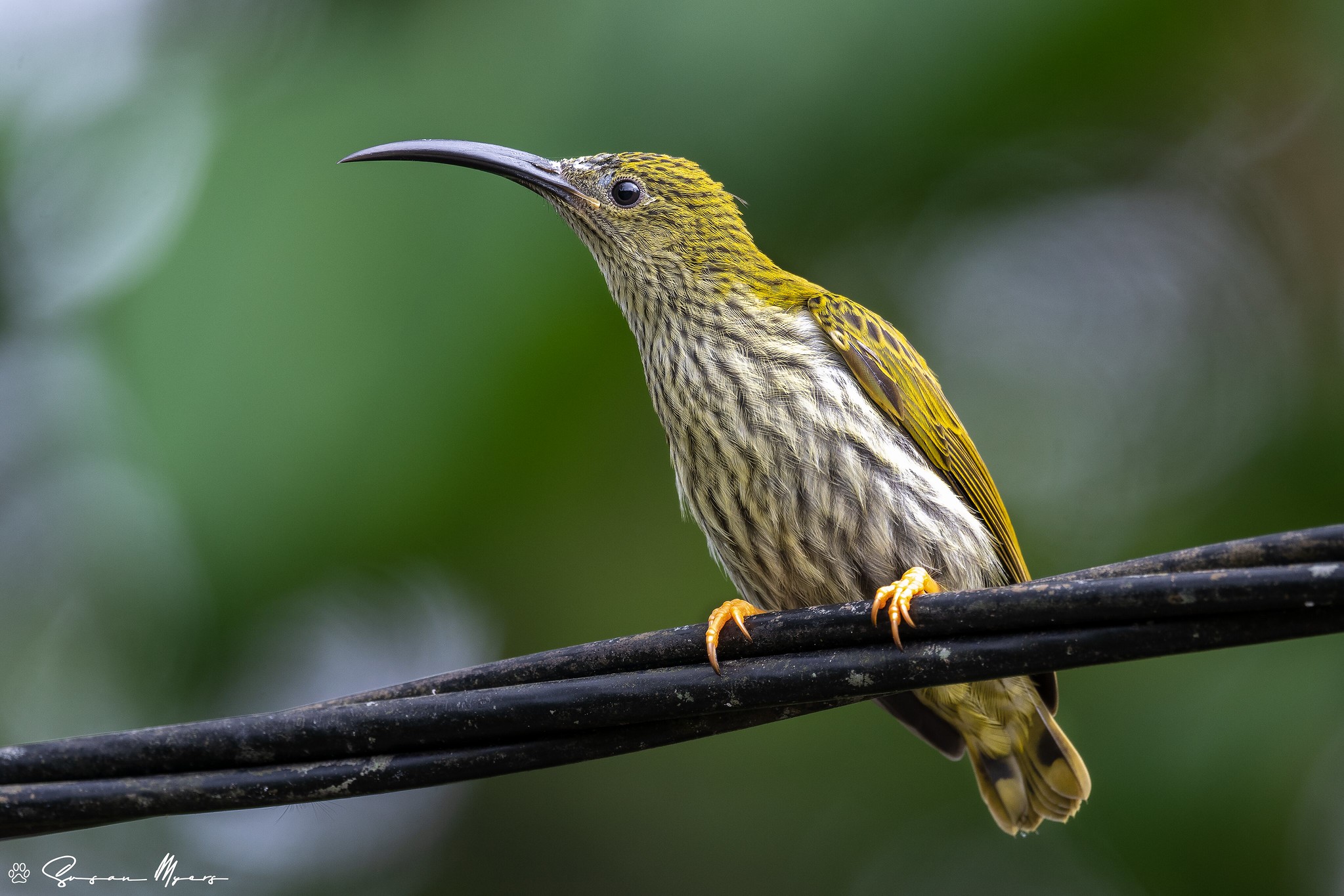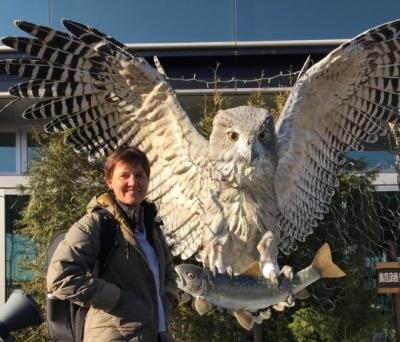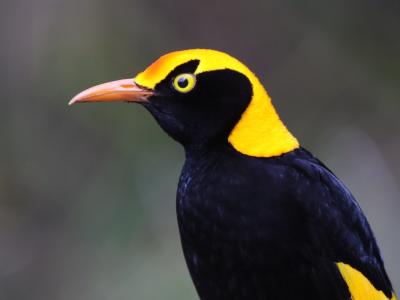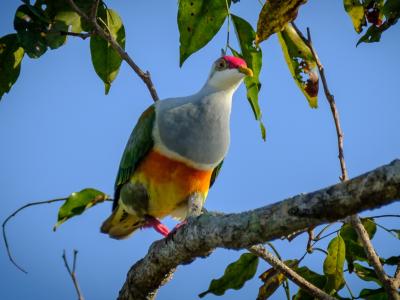Peninsular Malaysia
-
Jul 13-26, 2026
Susan Myers
Tour Price to be Determined

Tour Price to be Determined
About 720 bird species have been recorded in peninsular Malaysia, and a large proportion of these are resident, many unique to the area’s lush tropical rainforest. Our short tour revolves around three nights in the cool highlands at Fraser’s Hill, where the first migrants from the north augment the local avifauna, and five nights in the superb Sundaic lowland forest of magnificent Taman Negara, Malaysia’s largest national park. We’ll be targeting some very special birds, including Malayan Peacock-Pheasant, Great Argus, Malaysian Rail-babbler, Giant Pitta, Bamboo Woodpecker, and Ferruginous Partridge. This wonderful country remains one of the birdiest in Southeast Asia thanks to a system of excellent, well-protected nature reserves, its multicultural population, modern infrastructure, great food, and small towns with old-world charm help make Malaysia a comfortable and memorable birding adventure.
This tour can be taken separately or in combination with our tour of Borneo, the world’s third-largest island.
Day 1: Our tour begins this evening in Kuala Lumpur with a get-together dinner. Night in Kuala Lumpur.
Day 2: We’ll spend the morning birdwatching on the Old Gombak Road, where barbets, woodpeckers, spiderhunters, flowerpeckers, and sunbirds abound. This area provides a great introduction to Malaysian birds, and the list of even the common birds is tantalizing – Mountain Imperial Pigeon, Emerald Dove, Blue-crowned Hanging Parrot, Indian Cuckoo, Drongo Cuckoo, Chestnut-breasted Malkoha, Whiskered Treeswift, Oriental Dwarf Kingfisher, Scarlet Minivet, Great Green Leafbird, Green Iora, Grey-headed Canary Flycatcher, Asian Paradise Flycatcher, Thick-billed Pigeon, Little Cuckoo-Dove, Blue-eared Barbet, Banded Woodpecker and Banded Broadbill are all possible. It’s also a great place to look for the elusive Scaly-breasted Bulbul and maybe even Collared Babbler. After lunch, we’ll drive to the northwestern coastal town of Kuala Selangor. Night in Kuala Selangor.
Day 3: This morning we’ll visit the mangroves at Kuala Selangor, home to a number of special birds we are unlikely to encounter elsewhere on the tour, including Black Baza, Chestnut-bellied Malkoha, Mangrove Pitta (increasingly rare), Mangrove Whistler and Mangrove Blue-Flycatcher. In the afternoon we’ll drive to Fraser’s Hill. Night at Fraser’s Hill.
Days 4-5: Fraser’s Hill is a wonderful montane region, cool by comparison to Kuala Lumpur. There are plenty of exciting birds to look for in this wonderful birding area, including the spectacular and unlikely looking Fire-tufted Barbet, Black-and-crimson Oriole and Chestnut-capped Laughingthrush. We’ll also look for Wallace’s Hawk-Eagle, Malaysian Hill Partridge, Long-billed Partridge (rare), Yellow-vented Pigeon, Wedge-tailed Pigeon, Oriental Cuckoo, Brown Wood-Owl, Collared Owlet, Malaysian Eared Nightjar, Brown Needletail, Orange-breasted Trogon, and Red-bearded Bee-eater. Bushy-crested, Wreathed and Great Hornbills may be spotted, as well as Silver-breasted Broadbill and Rusty-naped Pitta (rare). We’ll also be on the lookout for Marbled (rare), Streaked and Eye-browed Wren-Babblers, Himalayan Cutia, the distinctive local subspecies of Lesser Shortwing, White-tailed Robin and the endemic Malaysian Whistling-Thrush. Nights at Fraser’s Hill.
Day 6: We’ll depart Fraser’s Hill this morning, birding along the Gap Road as we go. We should find Rufous-bellied Swallow, and we’ll also check the bamboo forests we pass for the elusive Bamboo Woodpecker. This bamboo specialist is scarce throughout its range, but this area is easily the best place to look for it.
After a stop for lunch at the town of Raub, we’ll drive east to Jerantut and Kuala Tembeling and then continue by car for about two hours following the course of the Tembeling River to the headquarters of Taman Negara at Kuala Tahan. We should arrive at our destination in the midafternoon for our first birding session in this bird-rich area. Night in Taman Negara.
Days 7-10: Taman Negara, located in the center of Peninsular Malaysia, covers 1,677 square miles of pristine forest and contains virtually all the bird species found in inland Malaysia. We’ll spend four days birding the numerous trails leading from our comfortable lodge into the surrounding lowland rainforest. Birds we hope to see include Crested Fireback; Blue-crowned Hanging-Parrot; three species of malkoha; two species of treeswift; Red-naped, Diard’s and Scarlet-rumped Trogons; Red-bearded Bee-eater; Black and Rhinoceros Hornbills; Brown Barbet; a dozen woodpeckers, possibly including White-bellied and Great Slaty; Black-and-yellow, Black-and-red and Green Broadbills; up to 15 bulbuls; Sultan Tit and many more. We’ll also hope to track down rare and elusive species such as Crested Jay, Gould’s Frogmouth, Garnet Pitta, Blue-banded Kingfisher, and Helmeted Hornbill, and we’ll have an opportunity to look for the Rail-Babbler an intriguing, elusive and enigmatic bird that ticks all the boxes! We’ll also take one or two boat trips – as we cruise in our open longboat, we should encounter riparian species such as Straw-headed Bulbul, Malaysian Blue Flycatcher, and possibly raptors and hornbills as they cross the river or move along the riverbanks. Birds aside, an added attraction is the opportunity to see a tremendous variety of rainforest plants and other animals during our walks. Nights in Taman Negara.
Day 11: Taking our leave of Taman Negara, we’ll make our way to Bukit Tinggi and, after checking in to our accommodation, we’ll head out to commence our birding at this mid-altitude site. We may encounter some similar birds here as we’ve seen on Fraser’s Hill, which will give us a chance to catch up on any species we may have missed there. There is also a good possibility of close sightings of the remarkable Siamang, the world’s largest gibbon. This area is also great for some scarcer species such as Blyth’s Hawk-Eagle, Grey-and-buff Woodpecker, and Scaly-breasted and Grey-bellied Bulbuls. Night near Bukit Tinggi.
Day 12: This morning we’ll bird at Bukit Tinggi, where we’ll head for a Mountain Peacock-Pheasant stakeout, a short walk up a forest track and out into an opening, where a blind has been set up. This location is likely the easiest place on earth to see this vulnerable endemic. With luck, we may also encounter the striking Ferruginous Partridge. These hard-to-find birds are now listed as near threatened on the red list due to ongoing habitat loss, and their populations are certainly declining, as with so many other ground-dwelling birds in the region. In the afternoon we’ll go up to the Cameron Highlands to bird at the highest point on the mountain along a quiet road where we will find some similar species to those seen at Fraser’s Hill, but also some scarcer species in Malaysia such as Bar-throated Minla, Golden-throated Barbet, Rufous-vented Niltava or Himalayan Cutia. Night near Bukit Tinggi.
Day 13: On our second day in the area, we may go to back to the hide again or make a return trip to the highlands, depending on what we’re still looking for. There are still plenty of great birds to look for in this area! Later in the day, we’ll head back to Kuala Lumpur in preparation for our flights tomorrow. Night in Kuala Lumpur.
Day 14: After breakfast, we’ll depart for Kuala Lumpur International Airport, where the tour concludes.
Note: The information presented below has been extracted from our formal General Information for this tour. It covers topics we feel potential registrants may wish to consider before booking space. The complete General Information for this tour will be sent to all tour registrants and of course supplemental information, if needed, is available from the WINGS office.
ENTERING MALAYSIA: U.S. citizens are required to have a passport valid for at least six months after the date of entry and with at least one blank page for an entry stamp. Visas are not required for a pleasure or business trip of 90 days or less.
Proof of yellow fever immunization is required for people coming from countries where the disease is endemic. No other immunizations are required for entry.
COUNTRY INFORMATION: You can review the U.S. Department of State Country Specific Travel Information here: https://travel.state.gov/content/travel.html and the CIA World Factbook here: https://www.cia.gov/the-world-factbook/. Review foreign travel advice from the UK government here: https://www.gov.uk/foreign-travel-advice and travel advice and advisories from the Government of Canada here: https://travel.gc.ca/travelling/advisories.
PACE OF THE TOUR: The average distance covered during our days in the field is a bit more than a mile per “birding period.” Our pace is very slow, of course, but on some days we may walk up to two and a half miles. Since there is a lull in the bird activity in the middle of the afternoon, midday breaks are usually scheduled. The mornings will not be too early as sunrise isn’t until 7 AM, departures from the hotel will mostly be around this time. We will generally take breakfast at or before dawn. Our proximity to the equator means the days are 12 hours long year round so dawn and dusk are around 7 am/pm respectively. Evening or early morning owling is offered where possible for those who want to participate.
Most of our birding will be on foot, away from the vehicles or along quiet roads (in which case the vehicle will usually be nearby). In order to find the more skulking birds such as pittas, partridges, babblers and so on we will also be birding on narrow forest trails at times. These trails are not paved and may be slippery or “rooty.” Where possible we will be walking on a downhill trend but of course the trails undulate so some uphill walking is required. You may find a hiking pole to be useful. Susan will inform the group of trail conditions ahead of time so that anyone who wishes to opt out has that opportunity.
HEALTH: The Centers for Disease Control and Prevention (CDC) recommends that all travelers be up to date on routine vaccinations. These include measles-mumps-rubella (MMR) vaccine, diphtheria-tetanus-pertussis vaccine, varicella (chickenpox) vaccine, polio vaccine, and your yearly flu shot.
They further recommend that most travelers have protection against Hepatitis A and Typhoid. Please contact your doctor well in advance of your tour’s departure as some medications must be initiated weeks before the period of possible exposure.
Malaria: The CDC recommends a malaria prophylaxis.
Yellow Fever: Yellow Fever protection is not recommended by the CDC but is required for entry into Malaysia if you’re coming from a country where the disease is endemic.
The most current information about travelers’ health recommendations can be found on the CDC’s Travel Health website here: https://wwwnc.cdc.gov/travel/destinations/list
Elevation: The maximum elevation we will bird at is approximately 5,900 ft/1800 m at the Timpahon Gate on Mount Kinabalu; our accommodation there is at approximately 4200 ft/1300 m. Our time at Kinabatangan is at sea level, while Danum Valley is in the foothills with an elevation of 980-1600 ft/300-500 m.
Smoking: Smoking is prohibited in the vehicles or when the group is gathered for meals, checklists, etc. If you are sharing a room with a nonsmoker, please do not smoke in the room. If you smoke in the field, do so well away and downwind from the group. If any location where the group is gathered has a stricter policy than the WINGS policy, that stricter policy will prevail.
Miscellaneous: Malaysia is remarkably free of intestinal complaints. Malaysians are very particular about their drinking water and drinking water in a restaurant or cafe will have already been boiled.
It is likely that we will find mosquitoes in some forest areas. We recommend using insect repellents with a high concentration of DEET.
CLIMATE: At Fraser’s Hill the daytime temperature ranges from about 70°F (mid-day) to the mid-50s F at night; while in the lowlands it reaches about 90°F. Night time temperatures will be correspondingly higher, as well. The humidity is quite high, averaging about 80% year round, which may make it seem hotter. Rainfall can be expected at any time in brief, heavy downpours. Total annual rainfall averages between 200 and 260cm (between 77-100 inches), the wet season typically runs from October to March, while the “not so wet” season is from April to September. There is always the chance of rain on any given day at any given time in Malaysia.
ACCOMMODATIONS: The Lodge in Taman Negara is a fairly upmarket wildlife lodge with air-conditioned rooms with private facilities and hot/cold water showers. The accommodation at Fraser’s Hill is a comfortable, western style hotel also with private facilities (albeit a little run down). Our hotel in Kuala Lumpur is a fairly typical large western-style hotel.
WiFi, Internet and Cell Phones: In the hotels in the main towns free Wi-Fi is generally available. Most require a password, which we’ll receive on check-in. Cell phones can be useful while on tour but keep in mind that many countries operate on a different cellular technology than US or Canadian carriers. Your phone may be incompatible with the local system, so please check with your local carrier.
FOOD: The food in Malaysia is generally delicious and varied with a combination of Chinese, Western and local Malaysian dishes. At the lodges the evening meals are in the form of buffets. The food in this part of the world has a reputation for being spicy but in Malaysian cuisine, chili or “sambal” (similar in some ways to salsa) is usually added to the meal at the table and is thus optional.
Drinks: Bottled water will be available in the field (we’ll keep a box full on the bus). At meals either bottled or filtered water will be available.
Food Allergies / Requirements: We cannot guarantee that all food allergies can be accommodated at every destination. Participants with significant food allergies or special dietary requirements should bring appropriate foods with them for those times when their needs cannot be met. Announced meal times are always approximate depending on how the day unfolds. Participants who need to eat according to a fixed schedule should bring supplemental food. Please contact the WINGS office if you have any questions.
TRANSPORTATION: Land travel will be in an air-conditioned 10-seater minibus. While in Taman Negara we may take one or two short trips by long boat. These boats are usually open and offer excellent wildlife viewing opportunities.
2023 Narrative
Kuala Selangor
We kicked off our birding explorations just north of the capital, Kuala Lumpur, at Kuala Selangor – a famous birding area known for its mudflats, mangroves and coastal scrub. After catching up with some of the more common, open country birds (Lesser Coucal, Asian Koel, White-throated Kingfisher, Coppersmith Barbet, Common Flameback, and so on) we headed to the mangroves for our main target in this area, the Mangrove Pitta. Our patience was rewarded as this hulking pitta with its enormous bill (specially adapted for crushing mangrove crabs) came into view. This excellent bird was greeted with lots of oohs and aahs!
After a particularly tasty lunch at our favorite riverside restaurant, we continued our birding at various locations in the Kuala Selangor area. Some of our other notable sightings included Lesser Adjutant storks at the Pantai Jeram mudflats, Baya Weavers and White-headed Munias at the Barat Laut ricefields, Lineated Barbet at Bukit Melawati, and a fabulous nesting pair of Crested Goshawks at our hotel.
Fraser’s Hill
We were all very excited to arrive at our next destination, the legendary birding destination of Fraser’s Hill. The next three days were simply a birding feast of the highest order! As we explored the quiet backroads of this lovely area, we came across so many great birds that it would take too long to list them all here. Some of the many highlights included many sightings of the bizarre Fire-tufted Barbet, gorgeous Long-tailed Broadbills, the world’s best-looking nuthatch – the Blue Nuthatch, incredibly confiding Lesser Shortwings (nothing lesser about this bird!), a great look at the remarkable Helmeted Hornbill, wonderful Sultan Tits, and many many more.
Taman Negara
As a complete contrast to the cool climes of the mountains, we next headed down to the steamy lowlands of the Malaysian tropical lowlands. Our destination, Taman Negara is the largest national park in the country covering an area of well over 4,000 square kilometres and the ancient rainforests it protects are estimated to be over 130 million years old. We birded many different areas in this outstanding reserve, including the gardens of our excellent lodge, as well as the Swamp Loop trail, the Blau and Yong Hides trails, and the Lubok Simpon trail. On one afternoon we took a boat trip up the lovely Tahan River - enormous rainforest trees covered in ferns and orchids bend over the river providing shade and habitat for a myriad of birds, insects and so many other animals. On the Swamp Trail we were all thrilled to find a very fine male Malayan Crested Fireback pheasant foraging just next to the boardwalk. We were able to watch and photograph this remarkable bird for quite some time before we moved on to find Olive-backed Woodpeckers, Black-throated Babblers, Scarlet-rumped Trogons and other very exciting rainforest denizens. We went twice to the Blau and Yong Hides trail, taking a short but very fun boat ride to the trailhead, then making a short climb up the riverbank before entering the forest to try for some of the more difficult birds that favour the denser jungle areas. Our persistence and patience rewarded us with views of some of these, including Crested Shrikejay, Black Magpie, Red-naped Trogon, Bushy-crested Hornbill, Malaysian Rail-babbler, and maybe best of all, the stunning Malayan Banded-Pitta.
Spending time in the gardens of our resort was also very rewarding, with sightings of Black-bellied Malkohas, Rhinoceros Hornbills, Black-and-yellow Broadbills, Green Broadbill, many different bulbuls and babblers, as well as Asian Fairy-bluebirds and Purple-naped Spiderhunters to name only a few. Our relaxing (yet exciting!) boat trip along the Tahan River also turned up some excellent birds, namely a Malaysian Blue-banded Kingfisher, one of the hardest kingfishers to find in Asia, the increasingly endangered Straw-headed Bulbul and the strictly riparian White-chested Babbler. Taking our leave of Taman Negara, we crossed back over the Tembeling River to Kuala Tahan, met up with our popular and very helpful driver, Steven, and then birded our way out of the rainforest, stopping for Black-thighed Falconets, Grey-bellied Bulbuls, and Baya Weavers along the way.
Bukit Tinggi
Bukit Tinggi means “High Hill” in English and it sure was nice to be in cooler climes again. But the real star of the show here might just have been our crazy accommodation! The Colmer Castle must be one of the strangest hotels in the world…
But our rooms were very comfortable and the hotel, which is surrounded by a huge expanse of beautiful hill forest, put us in a perfect location to enjoy some really special birding. Birding along the quiet roads and around the so-called Japanese Garden was very productive with neat sightings of Blyth’s Hawk-Eagle, Buff-rumped Woodpeckers, Whiskered Treeswifts, Wreathed Hornbill, Scaly-breasted Bulbul, and usual cohort of awesome Malaysian babblers, bulbuls, sunbirds, barbets and more. The main attraction was our stakeout for the Mountain Peacock-Pheasants though. This splendid bird is almost impossible to observe anywhere other than at this excellent hide, which also attracts Ochraceous Bulbuls, White-rumped Shamas and the rather poorly named Himalayan Striped Squirrel. This was a most fitting end to a very enjoyable and rewarding tour.
Thank you everyone for your excellent and enjoyable company. I’d also like to especially thank Lee Kok Chung for his outstanding birding skills and guidance throughout the tour. Steven, our driver, also deserves a shoutout for his friendly and helpful service and for his choice of restaurants!
Susan Myers, August 2023
Maximum group size eight with one WINGS leader.



